Shin Godzilla
August 5, 2017 · 1 comment
By Jasper Sharp.
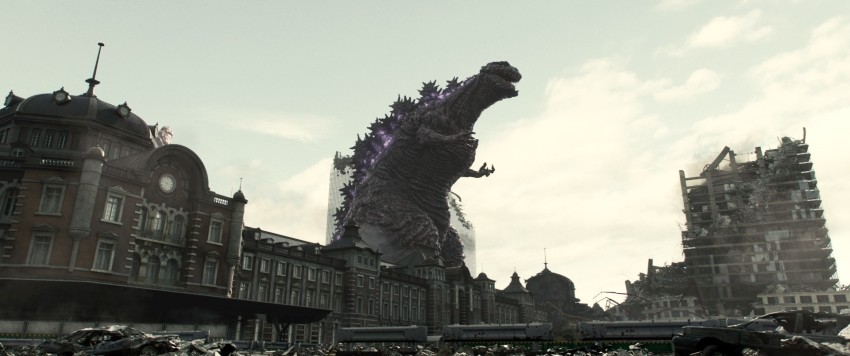 The world’s favourite movie monster returns to British screens this August in Shin Godzilla, which sees Japan’s legendary fire-breathing lizard once more rising from the cold blue depths of the Pacific to lay waste to huge swathes of Tokyo.
The world’s favourite movie monster returns to British screens this August in Shin Godzilla, which sees Japan’s legendary fire-breathing lizard once more rising from the cold blue depths of the Pacific to lay waste to huge swathes of Tokyo.
Released in July of last year, Toho’s latest reboot of a franchise that stretches back over 60 years to Ishiro Honda’s 1954 classic was the second top-earner of 2016 at the domestic box office (just behind Makoto Shinkai’s Your Name), while critics of Japan’s top film journal Kinema Junpo similarly voted it to the number 2 spot in their annual favourites list.
However, it has been a long and patient wait for us in the UK to see how this latest home-grown romp measures up against the 2014 version directed by Gareth Edwards, a film very much part of the same Hollywood tradition of co-opting foreign source material and repackaging it for a wider global audience that gave rise to Roland Emmerich’s earlier US remake in 1998.
Not that Toho, who announced the production of Shin Godzilla (“New Godzilla”) to mark the 60th anniversary of the birth of the legend in the same year that Edwards’ version appeared, have been innocent of their share of repackaging over the decades. Lets face it, the original film was prompted as much by the 1952 Japanese reissue of King Kong (1933) and the release of The Beast from 20,000 Fathoms (1953) as it was by the U.S. nuclear testing in the Pacific in 1954 that resulted in the irradiation of the crew of the Japanese fishing boat named “Lucky Dragon No. 5” (Daigo Fukuryu-maru).
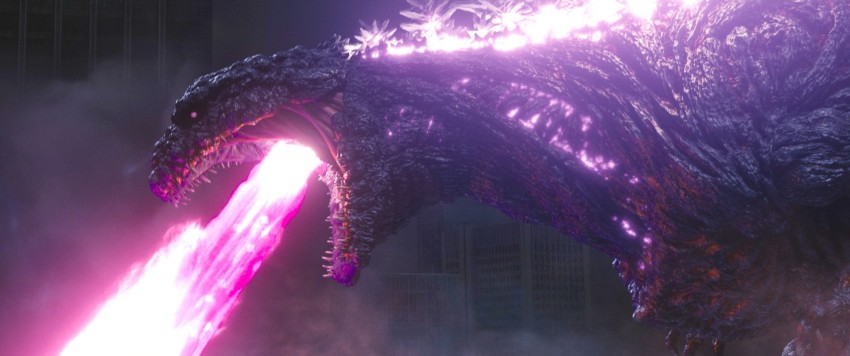 The first cycle of Godzilla films ended with Honda’s final work as a director, Terror of Mechagodzilla (1975), but the original producer of the series, Tomoyuki Tanaka, bounded back in 1984 to mark its 30th anniversary with a new film, directed by Koji Hashimoto, that shared the same Japanese title as the original yet was intended as a direct sequel (it went out with the English release title of The Return of Godzilla). This launched a second wave of six titles that culminated with Tanaka’s death in 1997. The third wave began with Godzilla 2000: Millennium (1999), directed by Takao Okawara, and climaxed with the Ryuhei Kitamura-directed Godzilla: Final Wars (2004), whose release coincided with the 50th anniversary of the creature’s first screen appearance.
The first cycle of Godzilla films ended with Honda’s final work as a director, Terror of Mechagodzilla (1975), but the original producer of the series, Tomoyuki Tanaka, bounded back in 1984 to mark its 30th anniversary with a new film, directed by Koji Hashimoto, that shared the same Japanese title as the original yet was intended as a direct sequel (it went out with the English release title of The Return of Godzilla). This launched a second wave of six titles that culminated with Tanaka’s death in 1997. The third wave began with Godzilla 2000: Millennium (1999), directed by Takao Okawara, and climaxed with the Ryuhei Kitamura-directed Godzilla: Final Wars (2004), whose release coincided with the 50th anniversary of the creature’s first screen appearance.
Shin Godzilla boasts Hideaki Anno of Neon Genesis Evangelion fame as both screenwriter and co-director, alongside Shinji Higuchi, another figure who emerged from the anime field but has since proven his mettle helming CG-driven special-effects extravaganzas such as the ill-conceived sci-fi/war fantasy Lorelei: The Witch of the Pacific Ocean (2005), the disaster movie Sinking of Japan (2006) and the 2015 two-part live-action adaptation of manga Attack on Titan.
Though it inhabits a parallel world to its predecessors, Shin Godzilla treads a cosily familiar narrative path with no major deviations from the formula: the leviathan breaks water in Tokyo Bay at the film’s opening and embarks on a trail of devastation across the city, while assorted politicians, scientists and military men grope for solutions to end its rampage.
In terms of special effects work, Shin Godzilla does, however, dramatically cut ties with its rubber-suit origins in favour of digital effects, although Godzilla himself retains the turkey-leg waddle of his pre-CG “suitmation” incarnations.
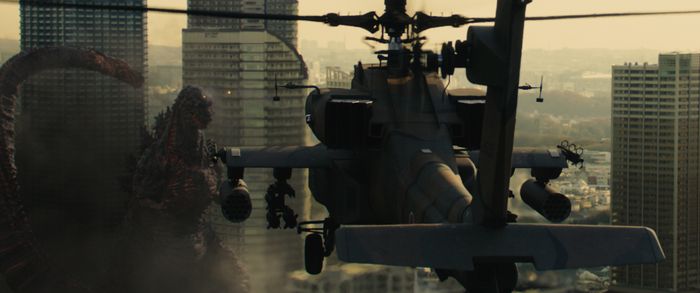 As ever there’s something liberating and undeniably fun in witnessing the strictures of contemporary metropolitan existence wiped away in a symphony of destruction, a trope hardly unique to Japan’s kaiju monster movies that can be seen in many an anime such as Akira (1988). It is interesting to note that King Kong never caused quite so much havoc in New York.
As ever there’s something liberating and undeniably fun in witnessing the strictures of contemporary metropolitan existence wiped away in a symphony of destruction, a trope hardly unique to Japan’s kaiju monster movies that can be seen in many an anime such as Akira (1988). It is interesting to note that King Kong never caused quite so much havoc in New York.
While Godzilla 2000 was the last of the Toho productions to get an American theatrical release, Shin Godzilla represents the first home-grown appearance of its star on UK cinema screens since I don’t know when. If the monster’s millennial outing can be seen as a reaction to Emmerich’s film, then the new “New Godzilla” provides a gentle reminder of where the character’s true genesis lies following Gareth Edwards’ attempt, something readily acknowledged both within Anno’s script and the greatest hits package of Akira Ifukube’s soundtracks from the first wave of films that plays out beneath the end credits.
Indeed, the main points of interest in the Godzilla films lie as much in the historical contexts as the national ones in which they were produced. Just as Honda’s film rose from the ashes of post-Hiroshima nuclear paranoia, it is impossible not to detect the fallout of Fukushima in this latest.
The arrival of this giant unidentified life-form is presaged by a dramatic leak springing in the Aqua-Line tunnel beneath Tokyo Bay, a vapour cloud arising from the boiling water above it. Undersea volcanic activity is initially suspected, as a deluge of boats is flushed along the Tama River into Tokyo. The city’s denizens line up in their hordes on the shores of Odaiba with their smartphones primed, and a cacophony of text messages is soon saturating the electronic ether of the internet. Information spreads like wildfire across social media sites, posted by users for whom carrying a Geiger counter has become second nature, and mass panic ensues, captured in shaky handheld footage.
When the instigator of this chaos emerges onto dry land, cod-eyed and floundering, its legs barely capable of supporting it out of water, it is barely recognisable as the iconic spiny-plated saurian we know and love. The question at this point is what exactly is it actually doing out of water, and where is it headed?
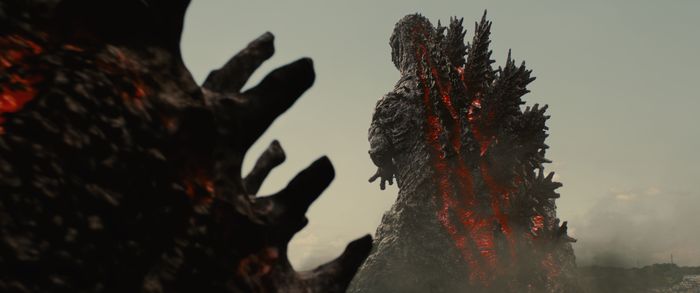 These initial scenes of devastation are counterpointed by the reactions of the throng of politicians and other governmental officials who convene to come up with some sort of emergency response. Debates rage as to whether the Self-Defence Force (SDF) should be mobilised for the first time since World War II, touching upon ongoing controversies in the real world as to the role of Japan’s military since the post-war constitution effectively barred the country from having a standing army.
These initial scenes of devastation are counterpointed by the reactions of the throng of politicians and other governmental officials who convene to come up with some sort of emergency response. Debates rage as to whether the Self-Defence Force (SDF) should be mobilised for the first time since World War II, touching upon ongoing controversies in the real world as to the role of Japan’s military since the post-war constitution effectively barred the country from having a standing army.
Part of the fun for regular viewers of Japanese film lies in picking out familiar faces from the pantheon of character actors amongst the crowd: Ren Osugi as the Prime Minister, Ken Mitsuishi as the Governor of Tokyo, Akira Emoto as Chief Cabinet Secretary, Kimiko Yo as the Defense Minister, Mikako Ichikawa as Deputy Director of Nature Conservation Bureau and Jun Kunimura as an SDF leader. Filmmakers such as Shinya Tsukamoto of Tetsuo fame, pioneering documentary-maker Kazuo Hara and Isshin Inudo (Josee, the Tiger and the Fish, La Maison de Himiko) also pop up onscreen briefly, before the key figures emerge from the dramatic maelstrom.
The main agents in the story are Yaguchi (Hiroki Hasegawa), the driven young Deputy Chief Cabinet Secretary for whom the emergency represents a perfect opportunity to prove himself, and Kayoco Anne Patterson (Satomi Ishihara, from Higuchi’s Attack on Titan films), a special envoy from the American government with a Japanese grandmother, a well-connected father and fearsome political ambitions of her own. Ishihara certainly adds a welcome a touch of glamour to the onscreen bombast, but she is wholly unconvincing as a Japanese-American. Her brash disregard of honorifics in her Japanese exchanges singles out her more hard-headed approach to getting the job done amongst the dithering of the senior government members, but despite a few simple tongue-tied rejoinders such as “sure thing” and “personal service”, it is obvious that most of the actress’ lengthier English-language enunciations have been post-dubbed.
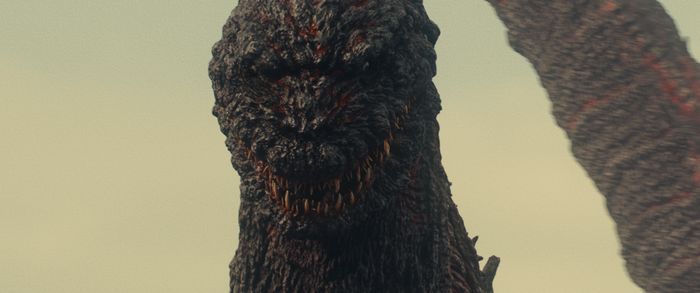 As the story progresses, it is revealed that Godzilla owes its existence to the unauthorised dumping of nuclear material in the ocean some 60 years ago, which caused the creature to mutate into its current form. As it continues its mutation on land, leaving a trail of radiation spikes in its path across the city, DNA samples show it has evolved to become the most genetically advanced being on the planet, capable of altering its entire structure through internal nuclear reactions. The dilemma is how to keep Godzilla well away from all nuclear facilities – potential food sources that would result in further mutation – while protecting Tokyo’s civilian population, without an attack that would cause the creature to release its own radioactive fallout.
As the story progresses, it is revealed that Godzilla owes its existence to the unauthorised dumping of nuclear material in the ocean some 60 years ago, which caused the creature to mutate into its current form. As it continues its mutation on land, leaving a trail of radiation spikes in its path across the city, DNA samples show it has evolved to become the most genetically advanced being on the planet, capable of altering its entire structure through internal nuclear reactions. The dilemma is how to keep Godzilla well away from all nuclear facilities – potential food sources that would result in further mutation – while protecting Tokyo’s civilian population, without an attack that would cause the creature to release its own radioactive fallout.
Of course, this latter aspect goes virtually ignored on the American side of the US-Japan Godzilla Research Coalition, happy to sacrifice Japan’s capital using the fight-fire-with-fire approach of a thermonuclear strike before the threat goes global. “That country foists some crazy things on us”, says the acting Prime Minister, who views the response as a pretext for America to subdue Japan once and for all.
Meanwhile, most of his cabinet appear more preoccupied with such economic considerations as the collapsing Yen and rapidly rising land prices in the west of the country. Not all of the internal and international machinations are wholly convincing, but then again, if you can swallow giant lizards appearing to destroy whole cities…
The new Japanese Godzilla might not stand as tall as its much bigger-budgeted American rival in the special effects stakes – although I feel more could have been done with the sound design to up the ante – and the lack of name foreign stars in the American and German roles comes across as an unnecessary piece of cost-cutting, lending an element of cheapo cheesiness reminiscent of the Toho’s original kaiju eiga of the 1950s and 1960s that that might well hamper its overseas appreciation.
Nevertheless, there is still a huge amount of enjoyment to be had in a film that remains remarkably faithful to the spirit of the original while still having things to say about the present-day geopolitical climate. Comparing it with the American version is ultimately pointless. It’s a different beast entirely. If comparisons are to be made, then looking at box-office performance against production budget, Shin Godzilla has already proven a more profitable endeavour than Edwards’, proof enough that even in the field of monster movies, bigger is not always better.
Shin Godzilla (Godzilla Resurgence) has a one-day screening all over the UK on 10th August.
Matthew
August 6, 2017 1:18 am
Surprised there wasn't any mention of both Hideaki Anno and Shinji Higuchi's time in Daicon Film (a pre-Gainax fan group). Though known primarily for the Daicon III and IV opening animations, their main output were short and low budget tokusatsu films. Higuchi was an uncredited assistant special effects director on the 1984 Godzilla film as well as being the special effects director on the highly acclaimed 1990's Gamera trilogy. While known primarily as an anime director, Anno is of course a tokusatsu tragic. In 2012 he directed the "Giant God Warrior Appears in Tokyo" short film which many have speculated was a pilot film demonstrating to Toho that he could take on the Godzilla project.